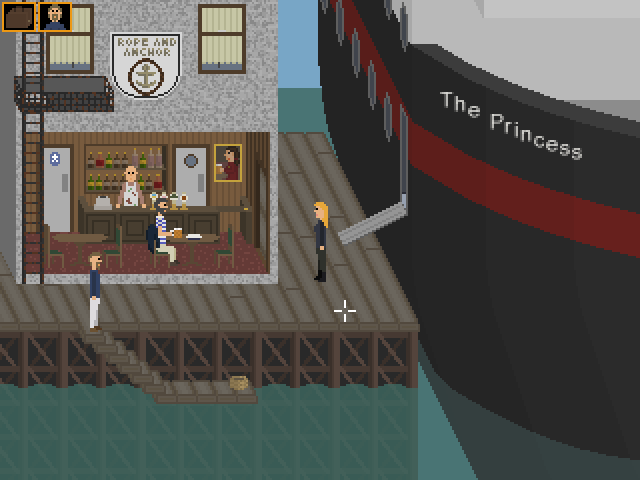 Every so often, a series arises that becomes permanently stamped into the chronicles of AGS history. It rewrites rules. Shows the potential of the genre. Becomes a deity and a symbol. Several titles spring to mind: the Chzo Mythos, Ben Jordan, King's Quest, Manic Mansion. Often imitated yet never bested, these games will live on and be played far after Chris Jones and crew packs in software design for good. If the first instalment is anything to go by, the McCarthy Chronicles looks to enter this lofty hall of fame. The series is the brainchild by new developer Calin Leafshade, whose flair and penchant for deep storytelling will surely earn him a place amongside his creation in the AGS hall of legends.
Every so often, a series arises that becomes permanently stamped into the chronicles of AGS history. It rewrites rules. Shows the potential of the genre. Becomes a deity and a symbol. Several titles spring to mind: the Chzo Mythos, Ben Jordan, King's Quest, Manic Mansion. Often imitated yet never bested, these games will live on and be played far after Chris Jones and crew packs in software design for good. If the first instalment is anything to go by, the McCarthy Chronicles looks to enter this lofty hall of fame. The series is the brainchild by new developer Calin Leafshade, whose flair and penchant for deep storytelling will surely earn him a place amongside his creation in the AGS hall of legends.
But on to the game. Our titular hero is Rick McCarthy, a morose 1940s private eye. Vilified by the public and local newspapers for his actions on his last case, he spends his days in a deep depression that threatens to engulf him. An urgent call to his office leads to a gruesome discovery in a church, with a box of matches the only lead to what happened. The matches lead him to the Grosvenor Hotel in the country, run by the sickly Michael and staffed by perky-yet-frightened maid Sarah. As McCarthy investigates the ancient hotel, it becomes very clear that something sinister is going on. There are strange howls at night. Constant guest Victoria sees strange, wolf-like shapes out of her window. And just where has the groundskeeper disappeared to?
There is so much to praise in Episode 1 that it is difficult to decide where to start. Possibly the best feature of the game is the meticulously-created atmosphere. I doubt a single person played the game without being captivated by the sinister, oppressive atmosphere all around the hotel. This atmosphere is generated with nothing more than rain, shadows, the sound of thunder and a subtly eerie music score. TMC is a horror game in every sense of the word, terrifying players without exposing them to so much as a hint of actual danger. Those who like to analyse games might be so bold as to guess that part of the hotel's dark and gothic appearance corresponds to the way McCarthy sees things in his intensely depressed mind. But perhaps that's looking too much into things.
The atmosphere is made even better by Leafshade's incredible attention to detail. Step in a puddle and you'll be treated to a squelching sound. Step on the wet gravel and you'll hear a pleasing crunch. The sound effects could not be better, and I'd be surprised if Calin didn't record them personally. As a result, they make the player feel as close to the game as possible, making things all the more unnerving.
Which is where we come to voice acting. Calin Leafshade has made a gutsy move making one of his first games with full voices, and it heightens the experience tenfold. The designer voices Rick McCarthy himself, giving the character considerable depth. All characters have highly believable voices, with special mention for the housekeeper Sarah. Not since Ben Jordan 7 have I seen such a realistic portrayal of a real person; out of all the leads, I'm sure many could imagine actually meeting her the most.
Honourable mention must be made in terms of interface. The McCarthy Chronicles has a unique control system that involves holding the left mouse button until the usual options (talk to, use, look at) appear. It confused me to start with but soon became preferable to the usual scrolling through icons to find the icon for legs to walk. I could also see it becoming cumbersome in later-episode tasks where split-second timing is essential, but apart from that it's above criticism.
It's probably time now to discuss the inevitable bread and butter of all games, the puzzles. While TMC:E1 isn't the most challenging game on the market, the tasks are innovative rather than standard. Calin Leafshade obviously subscribes to the game designer's doctrine that puzzles should be more believable than 'give me this miscellaneous multi-coloured item and I'll give you this key' style tasks. The player gets plenty of chances to utilise McCarthy's gumshoe skills and solve problems based on logic rather than simply using Item A on Object B and hoping for the best.
For those that like to get to the point rather than digest scores of paragraphs, The McCarthy Chronicles: Episode 1 is an incredibly imaginative, superbly atmospheric and creepy game. It features beautiful, gothic artwork and sound that deserves awards. The characters are well-developed and authentic to the setting, and the plot intricate and advanced. And for those that want things even more to the point? Play it. Then play it again. You'll be enthralled.
Final Score: 10/10
 Ah, the classic 21st. One last hurrah before the Terrible Twenties. Being vastly irresponsible and trying to piece together exactly what happened through the headachey next morning.
Ah, the classic 21st. One last hurrah before the Terrible Twenties. Being vastly irresponsible and trying to piece together exactly what happened through the headachey next morning. 


